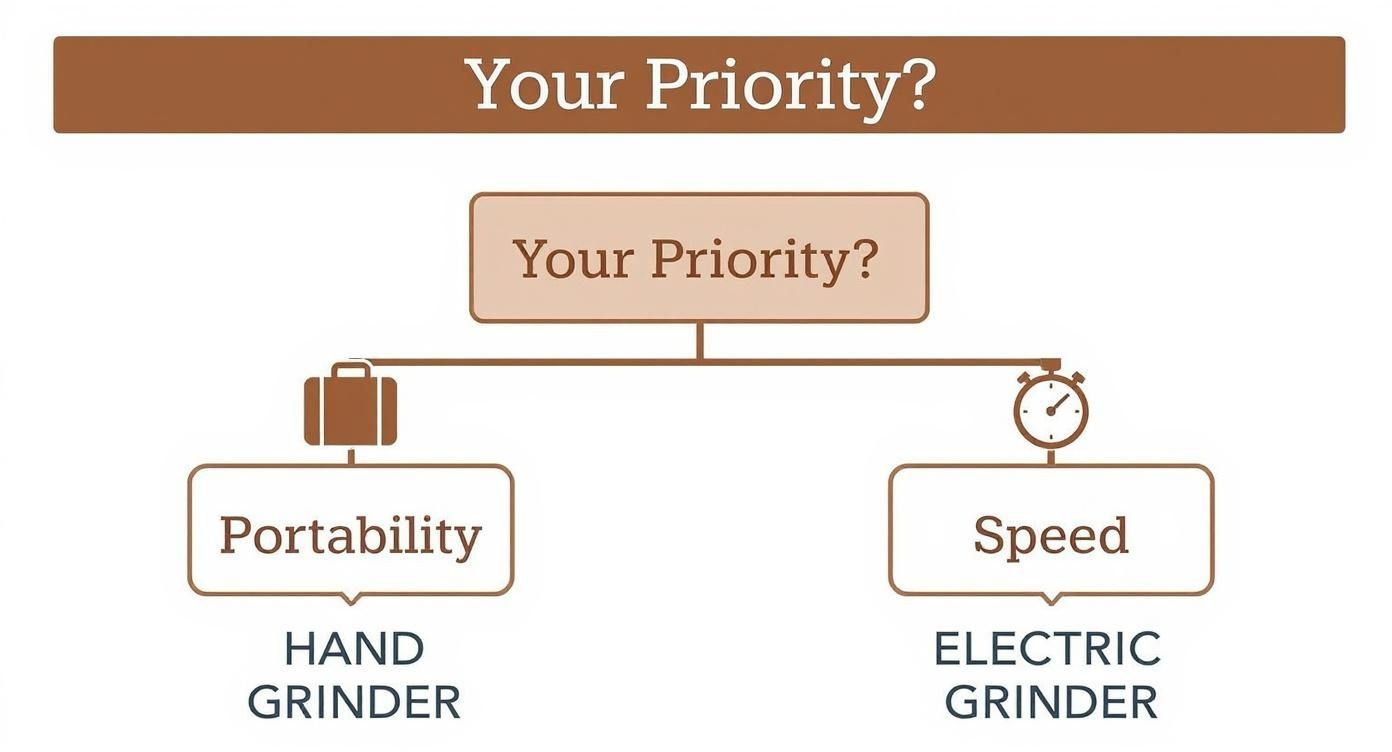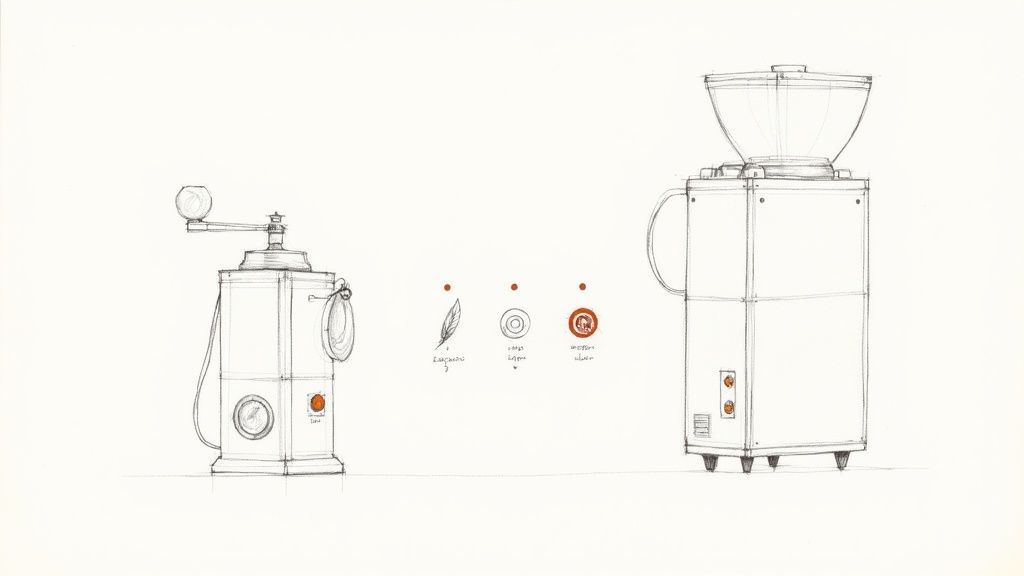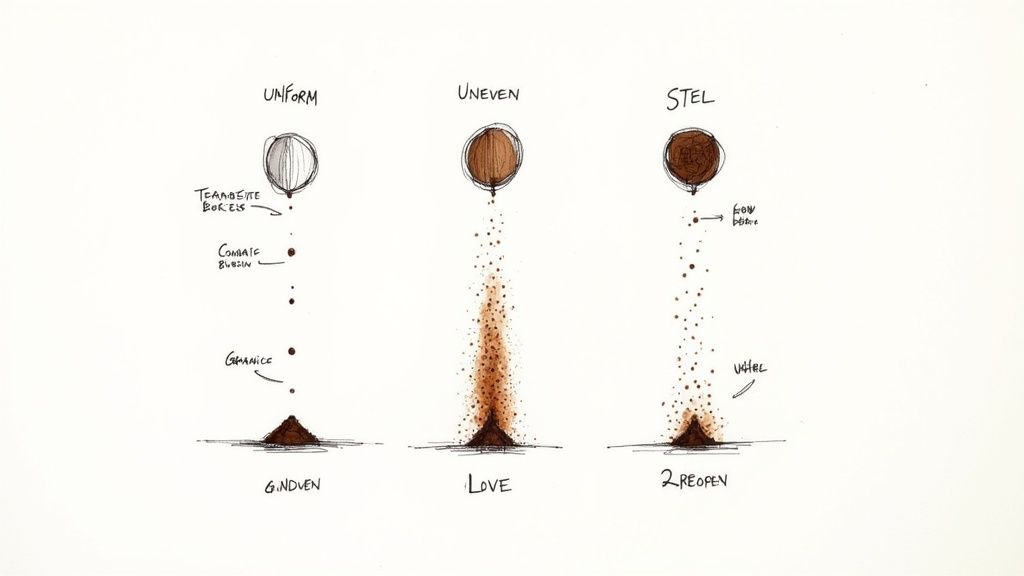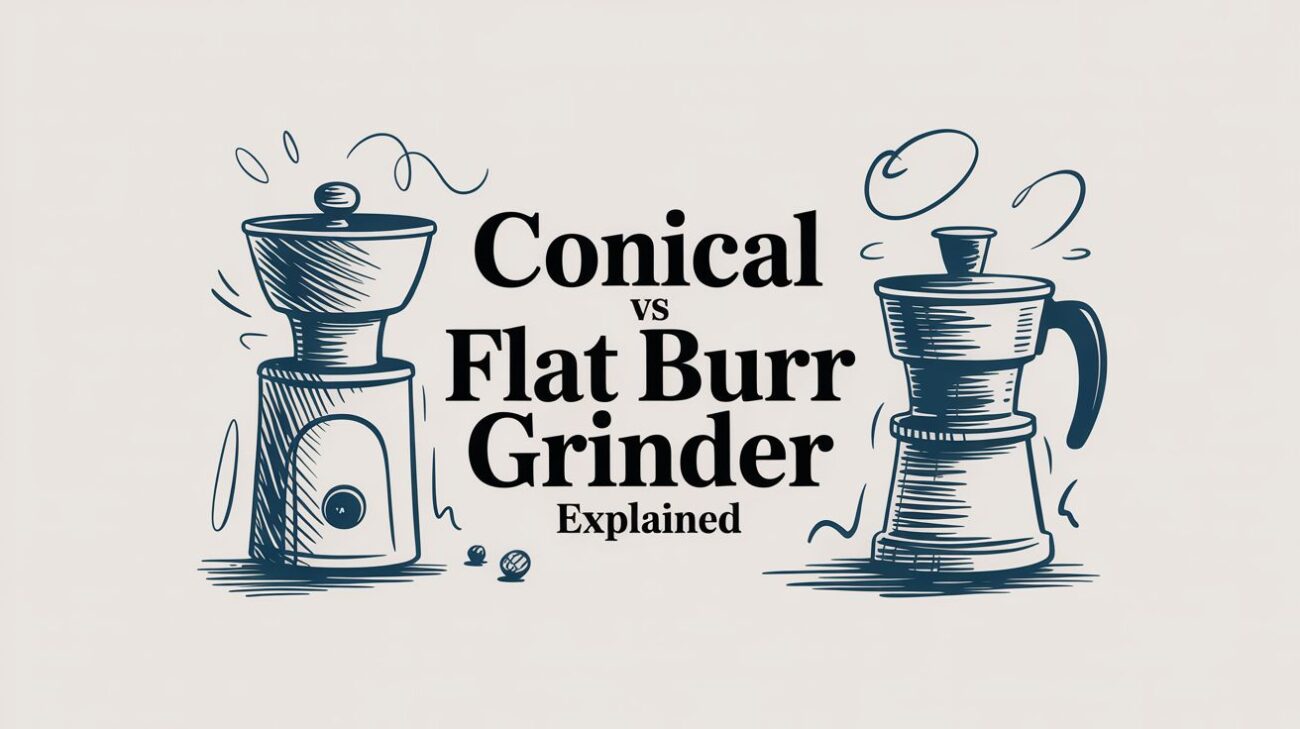Hand Grinder vs Electric Coffee Grinder UK Guide
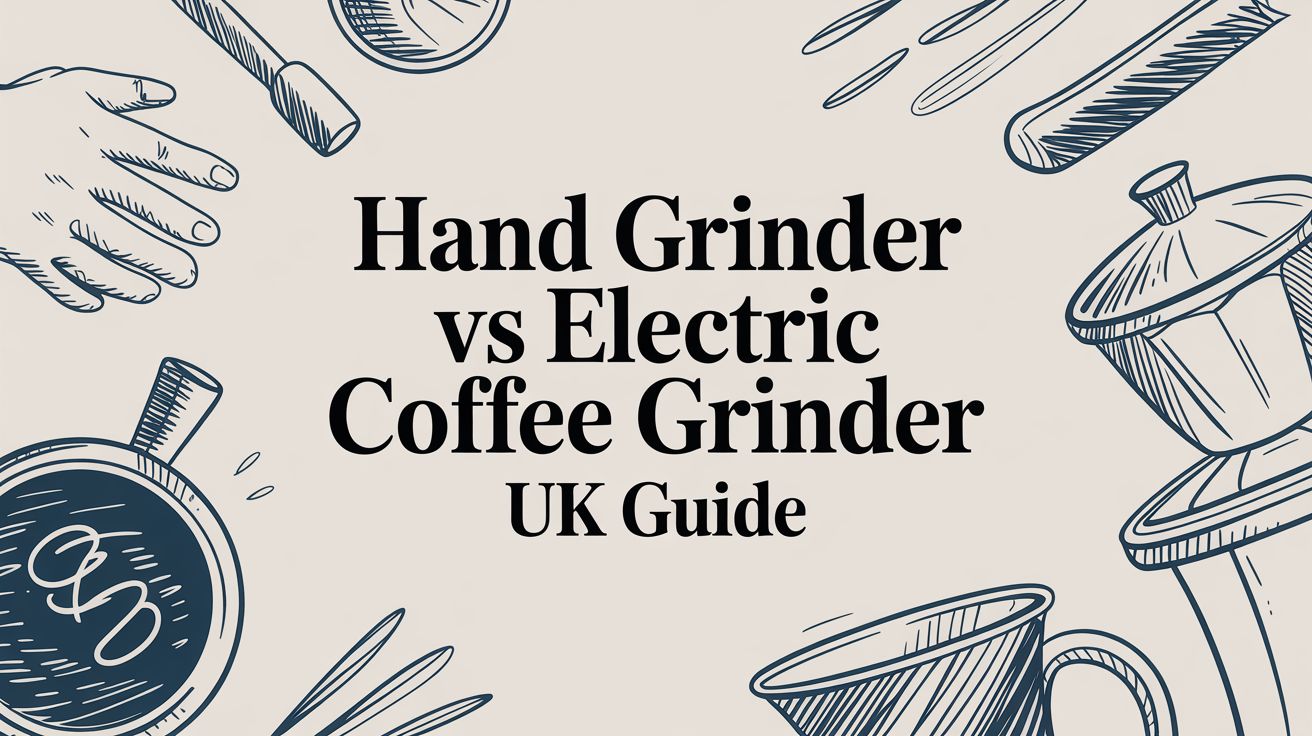
If you prize portability and a quietly meditative ritual, a hand grinder could be your ally. On the other hand, if speed and precision dosing top your list, an electric coffee grinder won’t disappoint.
Choosing Your Perfect Coffee Grinder
Think about how your grinder fits into your routine. A quick grind before the school run calls for different features than a leisurely Saturday morning brew.
- Brew on the move or in a tucked-away kitchen? A hand grinder brings a compact footprint, whisper-quiet operation and a tactile, hands-on feel. Browse our hand grinder selection at ADS Coffee Supplies.
- Pulling off multiple espresso shots or catering for guests? An electric grinder delivers repeatable grind sizes in seconds. Check out our electric grinder range at ADS Coffee Supplies.
Every setup is unique. Match core grinder features to your lifestyle—whether that’s wild camping at dawn or recreating café standards at home.
Practical Decision Factors
Start by weighing these five essentials to see which grinder aligns with your pace and priorities:
- Portability: How often will you grind away from a mains socket?
- Speed: Seconds saved on hectic mornings can be invaluable.
- Noise: Respect household quiet hours and shared spaces.
- Precision: Micro-adjustments matter for consistent shot quality.
- Cost: Balance your initial outlay against years of daily use.
For a curated selection of both manual and electric options, explore ADS Coffee Supplies.
Hand Grinder vs Electric Grinder At a Glance
Here’s a quick snapshot of how manual and electric models compare across the essentials.
| Feature | Hand Grinder | Electric Grinder |
|---|---|---|
| Portability | Lightweight and compact | Requires mains power and is bulkier |
| Noise Level | Whisper-quiet manual operation | Motorised noise ranging 60–70 dB |
| Speed | 30–60 seconds per dose | 3–10 seconds per dose |
| Precision | Depends on burr quality and hand effort | Micro-adjustments for repeatable settings |
| Cost | £25–£150 for quality models | £80–£500+ across entry to prosumer tiers |
This overview highlights why there’s no one-size-fits-all grinder; let your daily habits steer the choice. For detailed product options, visit ADS Coffee Supplies.
Quick tip Match your grinder to your morning flow instead of chasing the “best” model.
- Think about kitchen space and where you’ll store it.
- Evaluate how often you grind for espresso versus pour-over.
- Factor in noise tolerance if you share living quarters.
- Consider your budget and the value of long-term reliability.
For a deeper dive into how grind size shapes flavour, explore our guide on how to make coffee with beans.
To scout specific grinder models, browse our range at ADS Coffee Supplies.
In the end, your ideal grinder syncs with your morning pace, the level of precision you demand and the rituals you cherish. Choose wisely—and every cup will feel like second nature.
Why Grind Consistency Is Your Top Priority
Every cup begins with the grind. If particles range wildly from fine dust to coarse chunks, you’ll end up chasing sour notes on one sip and harsh bitterness on the next.
Maintaining consistent particle size guarantees that each fragment releases flavour at the same pace. In espresso, uneven grounds carve channels through the puck, producing hot spots and dull zones alike. Even the most exquisite beans from Seven Sisters Coffee Co can taste flat without a uniform grind.
Understanding Burr Types
The burr set is where size and shape come together. Conical burrs generally toss grounds out more efficiently, cutting down on heat buildup. Flat burrs, by contrast, demand more power but reward you with tighter particle distribution.
Material matters as much as geometry. Ceramic burrs shrug off wear and stay razor-sharp; steel burrs shrug off heavy use without chipping. Match your burr material to your daily grind volume and style.
| Burr Type | Natural Fit | Material | Consistency |
|---|---|---|---|
| Conical | Hand and travel | Ceramic | Moderate |
| Conical | Electric entry | Steel | Good |
| Flat | Prosumer electric | Steel | Excellent |
| Flat | Premium hand | Ceramic | Very Good |
Consistency is not just a spec; it transforms every cup from disappointment to delight.
Cheaper motorised grinders with subpar burrs churn out an erratic mix of fines and boulders. That randomness will drown out the delicate nuances of Seven Sisters Coffee Co’s single-origin and blend offerings.
Real-World Impact
Picture yourself brewing on the deck of a keelboat at dawn. A solid hand grinder outperforms a shaky mains-powered machine when the seas are rough. Yet at home, a well-tuned prosumer electric grinder will pull shot after shot with unfaltering precision.
In a busy café, baristas under pressure rely on micro-adjust systems delivering ±3 microns of repeatability. That tiny window means a stable extraction curve and happier customers day in, day out.
- Travel Scenario: Hand grinder in a tent prevents noise complaints.
- Busy Household: Electric grinder saves 50–60 seconds per dose.
- Brewing Method: Pour-over benefits from the tactile rhythm of manual grinding.
For a deeper dive into sizing your grind for various methods, check out our Coffee Grind Size Guide.
Hand Grinder Vs Electric Comparison
Both hand and electric units can be fitted with top-tier burrs, but it’s the motor and gearing that set them apart. A high-end electric grinder often boasts micro-step adjustments and dose memory. Meanwhile, a premium manual grinder can rival entry-level electrics for particle consistency.
- If you cherish ritual and portability, opt for a precision manual burr.
- When speed and programmable dosing matter most, invest in a quality electric model.
- Reflect on your daily flow: does a silent companion or an automated workflow suit you better?
Prioritising Burr Quality Over Motor
Think of the burr as the heart of your grinder and the motor as its support system. No matter how smooth the motor, uneven burr geometry will always betray you.
Follow these steps to assess burr quality:
- Inspect burr edges under direct light for uniformity.
- Compare burr diameter—larger sets often yield more even particles.
- Examine the finish; a matte ceramic surface usually signals artisanal craftsmanship.
- Read manufacturer specs and user reviews for tolerance details.
This hierarchy—burr before motor—ensures every cup highlights the subtle complexity of Seven Sisters Coffee Co roasts. For suitable burr-equipped grinders, explore ADS Coffee Supplies.
Building Consistency Into Your Routine
True uniformity extends beyond the grinder. It lives in your workflow, from bean to cup.
Keep these simple checks in your ritual:
- Measuring grind yield against input weight.
- Recording grind-dial settings in a dedicated notebook.
- Cleaning burrs weekly to maintain sharpness.
Routine calibration and maintenance lock in clarity. Combine these habits with the right grinder—manual or electric—and your cups will reflect your skill, not equipment flaws.
Mastering grind consistency is the final key to unlocking every note in your roast.
Whether you choose a hand grinder vs electric coffee grinder, consistency elevates taste.
Integrating A Grinder Into Your Daily Routine
Sunrise often finds you tiptoeing through a quiet kitchen, beans in hand. A hand grinder turns that moment into a ritual—each crank feels intentional, almost meditative. It’s a stark contrast to the burst-through-the-door chaos most of us face later in the day.
When the household wakes up en masse, the electric grinder steps in. It delivers a full dose in seconds, powering through back-to-back espressos for the weekend crowd. Just bear in mind: speed comes with noise and a higher power draw.
- Early-morning calm calls for slow rotations and sensory focus.
- Midweek rush demands rapid bursts to keep you on schedule.
- Limited counter space? A slim manual mill slips into a drawer easily.
- Hosting friends? Consistent, high-volume output from an electric unit keeps drinks flowing.
When Ritual Meets Efficiency
Evenings on the patio pair beautifully with a manual grinder’s soft whisper. Wildlife stays undisturbed while you engage all your senses, preparing both your mindset and your mug.
By contrast, weekday mornings reward programmable timers and hands-off dosing. Ask your smart plug to switch on the grinder before your alarm, then slide freshly ground coffee into an AeroPress without missing a beat.
“Choosing your grinder is about matching your rhythm, not following tech specs alone.” — Barista Tip
| Routine Aspect | Hand Grinder | Electric Grinder |
|---|---|---|
| Noise Impact | 25–35 dB | 60–75 dB |
| Setup Time | 30–60 seconds | 5–10 seconds |
| Storage Space | 50×50×150 mm | 120×200×300 mm |
This snapshot shows how noise, speed and footprint shape your workflow. In shared living areas, a quieter device preserves harmony, while compact flats often can’t accommodate a bulky electric grinder.
Selecting Your Daily Workflow
Start by mapping your own habits. Do you crave a grounding moment or crave a quick caffeine hit? Your answer steers you toward a hand grinder or electric machine—and away from buyer’s regret.
For deeper insight on how grind settings influence different brewing styles, explore our guide on coffee brewing methods.
If you’re ready to shop, ADS Coffee Supplies stocks a range of hand mills and electric burr sets designed for every routine.
Tips To Harmonise Your Routine
A little planning keeps your grinder feeling like a partner, not a chore:
- Preheat your grinder briefly to stabilise temperature.
- Jot down your favourite settings for each brew method.
- Label dials on both manual and electric grinders for quick recall.
- Group beans, grinder and brewer in one organised corner of your countertop.
Assess your rhythm and toolset to ensure every cup feels intuitive and uplifting.
Balancing Aroma And Convenience
A manual mill retains more oils, gifting you a richer aroma—albeit with a time investment. Electric models clear grounds swiftly, delivering a cleaner cup.
- Switch between both types to compare fragrance and speed in real time.
Aroma retention vs speed is a personal trade-off always worth exploring daily.
Evaluating Portability, Maintenance And Durability
Every grinder you buy becomes part of your ritual—shaping both your morning brew and your enjoyment over years to come. It’s not just about flavour consistency; it’s also about how easily you can pack it, keep it clean and trust it to last.
Hand grinders stand out when you crave mobility, whisper-quiet operation and straightforward mechanics. Electric models, on the other hand, churn through beans in seconds but demand a permanent spot and a steady power source.
The way you look after your grinder and how long it lasts can be just as important as whether it fits in your backpack.
- Adventures like camping or hiking benefit from a 700-gram hand grinder—no cords, no fuss.
- Busy office kitchens thrive on a 3-kilogram electric grinder, plugged in and ready for high throughput.
- Holiday cottages with unpredictable voltages often favour a simple hand mill for peace of mind.
All these factors feed into the real cost and value of your grinder over time.
Portability In Real World
It’s surprising how a manual burr grinder can nestle inside a daypack or suitcase. At just 25–35 dB, it lets you grind without disturbing roommates or dawn patrol on the campsite.
Contrast that with most electric grinders: they tip the scales at 1.5–3 kg and hum at 60–75 dB, demanding their own workspace and outlet. Frequent travellers often tuck their hand mill under the seat or layer it into a rucksack. Daily commuters appreciate a small footprint that tucks away beneath a desk. Electric units, however, stay anchored wherever there’s a mains socket.
“I never leave home without a hand grinder for my camper van trips.”
Maintenance Simplified
A clean burr means sharper cuts and a brighter cup. Hand grinders usually twist apart in seconds, revealing burrs and hoppers that you can brush out by hand. Electric machines often need tools to open chambers, making maintenance feel like a mini workshop task.
- Remove the hopper and give the burrs a brush to strip away oils.
- Wipe the catch cup with a soft cloth and mild detergent.
- Treat stubborn residue with specialist grinder cleaning products.
You can find a premium range of specialist grinder cleaning products at ADS Coffee Supplies.
Set your cleaning schedule according to use: weekly for heavy users, monthly for light ones. Ceramic burrs tolerate occasional soaking, whereas steel burrs may rust if left wet. A dab of food-safe lubricant on metal parts keeps things turning smoothly—but don’t overdo it or you’ll taint your beans.
| Grinder Type | Cleaning Frequency | Key Tools |
|---|---|---|
| Hand | Every 1–2 weeks | Soft brush, cloth |
| Electric | Monthly | Screwdriver, cleaning kit |
DIY repairs on electric grinders can void warranties, so always check the manual before you start tinkering.
Durability And Care
Hand mills rely on a simple gear train and robust steel burrs, so there’s little to go wrong when you’re on the road. Fewer moving parts means fewer breakdowns, but all metal will corrode if exposed to heat and humidity for too long. Keep yours with a few silica gel sachets and avoid damp kitchens.
Electric grinders pack motors, sensors and circuitry into a compact housing. A decent motor might serve you 5–10 years, yet the electronics inside become more delicate over time.
- Check handles and fastenings on manual mills every quarter.
- Inspect power cables and switches on electric grinders for any wear.
- Store both types in dry, temperature-stable spots to ward off rust.
- A replacement burr set for many hand grinders costs under £30, extending life affordably.
- Spare parts for electric models can run £50–£70, so preventative care is key.
Regular lubrication of manual burr shafts prevents squeaks and wear.
Annual servicing by an authorised dealer can add years to an electric grinder’s lifespan. Think about how long you expect to use your new grinder and factor in these upkeep costs.
For more on how your grinder aligns with different brew methods, check our guide on best coffee brewing methods.
Choosing between a hand grinder vs electric coffee grinder means balancing portability, maintenance and longevity against your daily habits. Replacement burrs for hand mills often fall under £20 per piece, whereas electric burrs push closer to £50–£70.
Estimate your total cost of ownership by adding purchase price, cleaning supplies and potential repairs. That way, your grinder becomes not just a tool, but a lasting partner in your coffee journey.
Comparing Cost And Long-Term Value
Choosing between a hand grinder and an electric mill isn’t just about the sticker price. It’s an investment in every cup you brew and the savings you’ll enjoy over years of daily use.
Entry-level hand grinders start around £25–£150, while electric models typically begin near £80 and can climb past £500 for prosumer units. Yet, when grind consistency and durability count, the cheapest option often proves false economy.
Price Breakdown And Value
When you pit a mid-range manual mill against an entry-level electric grinder, you’ll find similar grind uniformity—and often a longer lifespan—with the hand model. Market shifts in the UK from 2017 to 2023 reflect this trend: the coffee grinder sector’s Herfindahl-Hirschman Index jumped from 4140 to 5872, highlighting consolidation among leading brands and higher product standards. Read the full UK grinder market trends report on 6Wresearch.
“Investing in a quality grinder can save £500+ in café expenditures over three years.”
| Grinder Type | Entry Price | Expected Life | Burr Replacement Cost |
|---|---|---|---|
| Hand grinder | £25–£150 | 5–10 years | £20–30 |
| Electric grinder | £80–£500+ | 3–7 years | £50–70 |
Key takeaways:
- Hand Grinders: Low upkeep, reliable burrs, portable design
- Electric Grinders: Faster throughput, programmable doses, higher repair bills
- ROI: Savings from fewer café trips and fuller flavour extraction
Budgeting For Your Grinder
A realistic budget encompasses upfront cost, maintenance and possible repairs. Layer in the money saved by brewing at home, and you’ll see the payback period shrink rapidly.
For a comprehensive approach, combine your grinder choice with home roasting tools—check our guide on home coffee roasting equipment for expert advice.
Follow these tips to optimise your spend:
- Allocate £100–£200 for a dependable manual grinder if you value ritual and portability
- Reserve £150–£300 for an electric unit offering micro-adjustments and timer features
- Set aside a burr fund: £20–30 for hand mills, £50–70 for electric versions
Short-term gains come from cutting café expenses. Long-term, you’ll unlock more consistent extraction and prolong your beans’ freshness. Remember to factor in energy usage and cleaning supplies when crunching the numbers.
Smart budgeting ensures your grinder remains a long-term ally—day after day, cup after cup.
Which Grinder Suits Your Brewing Style
Choosing between a hand grinder and an electric coffee grinder comes down to how you like to brew. Espresso, pour-over and cold brew each demand a precise particle size to unlock their best flavours. Let’s match your favourite method with the grinder that brings out every nuance of Seven Sisters Coffee Co beans.
Espresso Requires Precision
Dialling in espresso means hitting 100–200 microns with laser-sharp accuracy. High-quality electric grinders equipped with specialist burrs deliver that level of control and speed.
- ±10 Micron Consistency: Even extraction shot after shot.
- 18–20 g in Under 5 Seconds: Keeps up with a busy café workflow.
- Programmable Dosing: Pre-sets reduce human error under pressure.
For seamless integration with your machine, explore our range of espresso machines.
Pour-Over And Portable Brewing
If you savour the ritual of pour-over or AeroPress—especially on the move—a hand grinder is hard to beat. It gives you full tactile control over grind size and slips easily into a daypack.
- 200–300 µm for V60: Optimises flow rate and clarity.
- 300–400 µm for AeroPress: Balances strength and acidity.
- 25–35 dB Noise Level: Keeps campsites and kitchens peaceful.
A compact manual mill transforms each brew into a deliberate, hands-on moment.
Browse our filter-brewing kit at V60 and other pour-over brewers.
French Press, Moka Pot And Cold Brew
Coarse brewing methods play by different rules. French press loves 800–1000 µm particles for a full-bodied cup, while the Moka pot needs 300–500 µm, sitting neatly between espresso and filter. Cold brew demands extra-coarse 1000+ µm grounds steeped over 12–16 hours.
Electric grinders switch between these settings in seconds. Yet, a well-made hand mill minimises fines and encourages you to explore subtle tweaks.
| Method | Grind Range (µm) | Best Grinder Type |
|---|---|---|
| French Press | 800–1000 | Hand grinder to control coarse particles |
| Moka Pot | 300–500 | Electric grinder for speedy repeatability |
| Cold Brew | 1000+ | Hand grinder to avoid excess fines |
Matching your grinder to brew style turns everyday technique into genuine confidence.
Whether you’re aiming for a bold espresso or a crisp filter cup, picking the right grinder makes every sip more intentional.
Choosing Based On Your Daily Goals
Think about when and where you brew. That tells you whether serenity or speed should come first.
- Map Your Routine: Kitchen counter, office desk or a morning hike.
- Weigh Speed vs Ritual: Is five-second dosing more valuable than hand-crank calm?
- Consider Cleanup & Noise: Shared flats and early-hour neighbours demand quiet operation.
Try a weekend brunch with friends: a hand grinder keeps noise low and grind quality uniform across multiple French press batches. Contrast that with a hectic weekday rush—programmable electric dosing delivers consistent grounds for you and your colleagues, every time.
You can even blend both approaches: a quick manual pre-grind for filter coffee, then switch to electric for precision espresso. This hybrid routine slides seamlessly between mindful mornings and on-the-go caffeine fixes.
Ultimately, align your grinder choice with the brew you cherish—and savour every drop of Seven Sisters Coffee Co flavour.
Frequently Asked Questions
Deciding between a hand grinder and an electric model naturally sparks a few key questions. Below, you’ll find straightforward answers drawn from real-world experience to steer you toward the right choice.
-
Are Hand Grinders Good Enough for Espresso?
Yes—but with caveats. High-end manual mills can dial in an espresso-fine grind, yet it demands patience and muscle. By contrast, an electric burr grinder equipped with a robust motor and micro-adjustments delivers consistent shots in seconds, cutting down on trial and error during your morning rush. -
How Much Should I Spend on My First Coffee Grinder?
It really depends on your brewing style and budget. A quick comparison:Grinder Type Price Range Hand Grinder (Filter Use) £50–£150 Entry-Level Electric Burr £100–£200 Investing in quality from the start pays off. By prioritising grind precision early on, you could save over £500 in café purchases across three years.
Do You Need a Burr Grinder
A burr mechanism is non-negotiable if you care about even extraction and flavour clarity. Unlike blades, burrs crush beans to uniform sizes, so you avoid sour pockets or bitter over-extractions.
- Ceramic or steel burr sets deliver repeatable results, day after day.
- Consistent particle size means reliable bloom, steady flow and balanced cups.
- From fine espresso to coarse French press, a burr grinder underpins every brewing method.
Key Insight: A good burr grinder transforms hit-and-miss mornings into vibrant, reliable brews.
If you’re on the hunt for specific models, explore our guide on coffee grinders at ADS Coffee Supplies. They showcase both manual mills and electric burr sets to suit diverse budgets and brewing techniques.
To finalise your decision, consider these practical steps:
- Test-grind beans at a local retailer to feel the difference in effort and speed.
- Keep a simple log of grind settings matched to each brew method.
- Schedule a quick clean-out every 4–6 weeks to prevent stale grounds buildup.
- Factor in how much counter or preparation space you have during peak brewing hours.
If you’re searching for exceptional beans and a grinder that complements your technique, visit Seven Sisters Coffee Co online at https://sevensisterscoffee.co.uk

